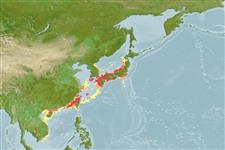Environment: milieu / climate zone / depth range / distribution range
Ecologia
marino demersale. Subtropical
Distribuzione
Stati | Aree FAO | Ecosystems | Presenze | Point map | Introduzioni | Faunafri
Western Pacific: Japan to the Philippines.
Size / Peso / Age
Maturity: Lm ? range ? - ? cm
Max length : 12.2 cm SL maschio/sesso non determinato; (Ref. 33416)
Short description
Chiavi di identificazione | Morfologia | Morfometria
Spine dorsali (totale) : 9; Raggi dorsali molli (totale) : 12; Spine anali: 3; Raggi anali molli: 12. Lateral line scales 27, plus 1 on the base of caudal fin; nearly always 13 pectoral rays (rarely 14), females without dark caudal spot; longest dorsal soft ray ranges from 1.95-2.3 in HL (Ref. 33416).
Life cycle and mating behavior
Maturities | Riproduzione | Spawnings | Egg(s) | Fecundities | Larve
Randall, J.E., 1999. Halichoeres bleekeri (Steindachner & Döderlein), a valid Japanese species of labrid fish, distinct from H. tenuispinis (Günther) from China. Ichthyol. Res. 46(3):225-231. (Ref. 33416)
IUCN Red List Status (Ref. 130435)
Threat to humans
Harmless
Human uses
Strumenti
Special reports
Download XML
Fonti Internet
Estimates based on models
Preferred temperature (Ref.
123201): 16.1 - 27.1, mean 22 °C (based on 84 cells).
Phylogenetic diversity index (Ref.
82804): PD
50 = 0.5000 [Uniqueness, from 0.5 = low to 2.0 = high].
Bayesian length-weight: a=0.00955 (0.00451 - 0.02020), b=3.09 (2.92 - 3.26), in cm total length, based on LWR estimates for this Genus-body shape (Ref.
93245).
Trophic level (Ref.
69278): 3.4 ±0.5 se; based on size and trophs of closest relatives
Resilienza (Ref.
120179): Alto, tempo minimo di raddoppiamento della popolazione meno di 15 mesi (Preliminary K or Fecundity.).
Fishing Vulnerability (Ref.
59153): Low vulnerability (10 of 100).
